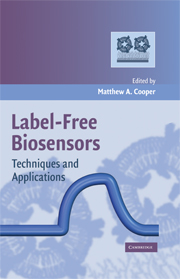Book contents
- Frontmatter
- Contents
- Contributors
- Preface
- LABEL-FREE BIOSENSORS
- 1 Label-free optical biosensors: An introduction
- 2 Experimental design
- 3 Extracting affinity constants from biosensor binding responses
- 4 Extracting kinetic rate constants from binding responses
- 5 Sensor surfaces and receptor deposition
- 6 Macromolecular interactions
- 7 Interactions with membranes and membrane receptors
- 8 Application of SPR technology to pharmaceutical relevant drug-receptor interactions
- 9 High-throughput analysis of biomolecular interactions and cellular responses with resonant waveguide grating biosensors
- 10 ITC-derived binding constants: Using microgram quantities of protein
- 11 Electrical impedance technology applied to cell-based assays
- Index
- Plate section
2 - Experimental design
Published online by Cambridge University Press: 05 May 2010
- Frontmatter
- Contents
- Contributors
- Preface
- LABEL-FREE BIOSENSORS
- 1 Label-free optical biosensors: An introduction
- 2 Experimental design
- 3 Extracting affinity constants from biosensor binding responses
- 4 Extracting kinetic rate constants from binding responses
- 5 Sensor surfaces and receptor deposition
- 6 Macromolecular interactions
- 7 Interactions with membranes and membrane receptors
- 8 Application of SPR technology to pharmaceutical relevant drug-receptor interactions
- 9 High-throughput analysis of biomolecular interactions and cellular responses with resonant waveguide grating biosensors
- 10 ITC-derived binding constants: Using microgram quantities of protein
- 11 Electrical impedance technology applied to cell-based assays
- Index
- Plate section
Summary
INTRODUCTION
Label-free detection is a key factor contributing to the increasing popularity of biosensors, in particular those based on surface plasmon resonance (SPR). By measuring changes in refractive index close to a sensor surface, SPR biosensors allow the user to study the interaction between immobilized molecules (often referred to as ligands) and analytes in solution, in real time and without analyte labeling. Observed binding rates and levels can be interpreted in different ways to provide information on the specificity, kinetics, and affinity of the interaction or for determination of the concentration of the analyte. The ease by which this information is obtained has changed customer workflows in antibody and small-molecule interaction analysis, and in screening. There is now a clear shift from label-based and affinity/IC50-based workflows to a label-free and kinetic-based workflow.
Over the last 20 years I have obtained my knowledge and experience in the biosensor field in development and use of Biacore systems (GE Healthcare Companies), but the information provided in this chapter is general and therefore relevant to many label-free platforms.
Biacore systems commonly integrate detection, sensor surface, and liquid handling technologies and have multispot capability, that is, they allow independent and simultaneous measurements on several discrete spots on a single surface. Ligands can be attached to the sensor surface through a variety of chemistries, and the liquid handling system makes it possible to inject reagents and samples into different flow cells. Samples can be injected in sequence to build multimolecular complexes, but in most cases formation of the complex between the immobilized ligand and one analyte is investigated.
- Type
- Chapter
- Information
- Label-Free BiosensorsTechniques and Applications, pp. 29 - 47Publisher: Cambridge University PressPrint publication year: 2009



